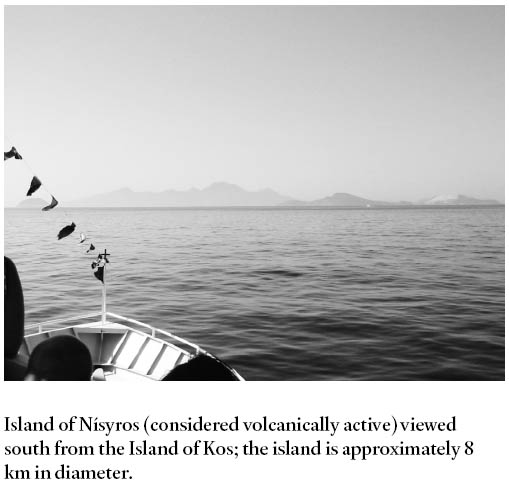The igneous rocks of Greece: The anatomy of an orogen. Georgia Pe-Piper and David J.W. Piper.
David R. LentzDepartment of Geology, University of New Brunswick, Fredericton, NB
Georgia Pe-Piper and David J.W. Piper. The igneous rocks of Greece: The anatomy of an orogen. Gebrüder Borntraeger, Berlin, 200298 Euro, hardcover ISBN 3-443-11030-4
1 Evident in the title, this new book by our close colleagues here in the Maritimes represents a comprehensive synthesis of a complex young orogen through the eyes of two very experienced geologists. Since it is impossible to capture essence of this book better than the back cover's two paragraph synopsis (see below), I have decided to quote it. The Hellenide orogen in Greece is part of the Alpine-Himalaya mountian belt, created during the destruction of Tethys by the convergence of Gondwana and Eurasia. Within Greece, there is the record of a complete Wilson tectonic cycle of continental rifting, sea-floor spreading, plate subduction, and continental collision during Mesozoic and Cenozoic time. This book presents a new synthesis of the geological history of Greece as revealed by the varied igneous rocks. It is based on more than 30 years of fi eld and laboratory studies by the authors together with a synthesis of the widely scattered published literature that has been written in many different languagues. Basement rocks record Hercynian subduction and plutonism on the northern margin of Gondwana, which in the Permian and Triassic rifted into several microcontinents, thereby creating the eastern Mediterranean Neotethys ocean. Partial closure of strands of the Neotethys ocean resulted in widespread emplacement of Jurassic and Cretaceous ophiolites. Early Tertiary collision produced a Hellenide mountian chain similar to the Alps and Himalayas. Rapid Neogene extension of the Hellenides behind the modern South Aegean arc has formed the Aegean Sea, triggered widespread back-arc igneous activity, and unroofed mid-crustal rocks. The geological setting, geochemistry, and tectonic signifi cance of each group of rocks is presented in detail, with numerous original maps and figures.
2 Considering who the authors are and the publication this is to appear in, I have decided that a more personal book review style is most appropriate and the fact that I'm truly humbled by the breadth and depth of this contribution and their commitment to our science. I know others concur with my view, as out of curiosity I checked out other reviews by igneous petrologists and regional experts. Although there is an obvious emphasis on the igneous rocks in the region, this is much more that just a synopsis of igneous rocks of Greece. This book is a template for using igneous petrology to dissect "the anatomy of any orogen"; I use it extensively in my volcanology class and refer to it regularly for certain parts of my research. Although for these authors this book could have been titled "how we spent our summer vacation", that would just reflect my jealously having only had the great opportunity to visit a few of the Greek Islands, just when this book first appeared in my library last year. Georgia and Dave were doing anything but vacationing as this book reflects an immense amount of original research that they have done over the years. In fact, I used it as a guide to the few parts of the region I visited as nothing geological comes close to its detailed geology of Greece. After visiting the island of Kos (home of the father of modern medicine (Hippocrates) and Georgia's home island) on my way to the smaller active volcanic island of Nísyros, I immediately realized where Georgia developed her passion for volcanic systems with majestic rhyolitic flows to bedded pyroclastic cliff sections on her doorstep and a classic volcanic edifice (Nísyros – see photo below) visible just to the south, inspiring to anyone who visits.
3 From the macroscopic to microscopic perspective coupled with a chronologic organizational style, the book begins with a detailed review of the geology and tectonic evolution of the overall region, while integrating their new ideas into this anatomy lesson. The book then delves into nitty gritty of each region like a cadaver to a forensic pathologist, laying out the meticulously gathered evidence and building the case for a new systematic stratigraphic, petrologic, geochemical, and isotopic analysis of the geologic history of the region; the many analytical tools of our profession are put on this case. Case closed?….far from it; this region seems to be heating up in terms of new research potential in fundamental areas of geoscience, including igneous petrology; alas the reason for my unfortunately all-too-short a visit. It is well known that an empirical research synthesis like this can "break the case wide open", i.e., the foundation is laid for other exciting research, much to the credit of these internationally recognized authors' hard work in on this natural laboratory they call Greece. In Atlantic Canada, I've always been in awe of the phenomenal dedication, talent, and research excellence all around me that is truly inspirational. Buy the book, savour the wealth of information and passion that went into it, and if you can visit the region; you definitely won't be disappointed.
Island of Nísyros (considered volcanically active) viewed south from the Island of Kos; the island is approximately 8 km in diameter.